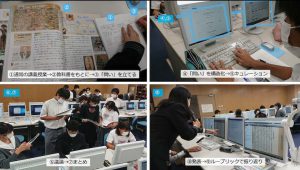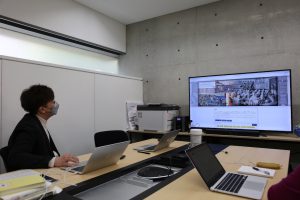
May 10, 2022
教育現場にデジタルアーカイブをつなぐ:大井将生さんインタビューConnecting Digital Archives to Educational Fields: An Interview with Masao Oi
学際情報学府の学生の中には、社会人経験を持ち、現場での問題意識がきっかけで研究をしている人は少なくありません。デジタルアーカイブの教育活用をテーマに実践的な研究を行っている大井将生さん(文化・人間情報学コース博士課程1年、渡邉研究室)もその一人です。
10年にわたって高等学校で社会科教諭として教壇に立ち、教材開発にも携わった経験をお持ちの大井さんは、大きく2つの研究の問いを持っています。ひとつは、図書館・博物館などにストックされた状態で教育現場に届いていない各地の多様で豊かな資料や文化資源を、いかに学校現場に届け、いかに活用することで新たな知を創出することができるか。もうひとつは、教育現場と多様な資料や文化資源、そしてウェブ上に散逸するさまざまなコンテンツや情報をいかにリンクすることで知の循環を促進することができるか。どちらも現場経験で芽生えた問題意識がもとになっているといいます。
修士課程では、多様な資料と学習者の問いの接続を支援するためのデジタルアーカイブ活用デザインについて研究しました。具体的には、探究学習において、国の分野横断型検索プラットフォームである「ジャパンサーチ」を利活用し、学習者の批判的な思考力や多方面の視座を育むことを目指す長期的な授業実践を試みました。学習者が教科書の記述や教員の説明をただ単に「覚える」「聞く」のではなく、自ら問いをたて、その答えを探求する過程でデジタルアーカイブを主体的に活用し、問いと資料を接続する授業をデザインしたそうです。また、学習者が「教科書の中の出来事/歴史/過去」に対する時空間の距離を乗り越えて、自分ごととして学びに向かう様子がみられたそうです。
4月に博士課程に進学した大井さんは、「教えられる側」ではなく、「教える側」のデジタルアーカイブの活用について研究を始めています。すでに、小中高の教員など学校関係者や図書館・博物館などの資料提供者が協創的に多様な資料を学校教育で活用できるように「教材化」し、学習者の問いを創発する新たな枠組みとコミュニティを構築しています。また、文部科学省が公開している学習指導要領とさまざまなデジタルアーカイブ、そして学習者の学びを繋ぐLOD(Linked Open Data)化による「データのネットワーク」の開発も進めています。
研究成果がすでにさまざまなところで評価されている大井さん。デジタルアーカイブを問いに基づいた深い学びの基盤として利活用するために、「データのネットワーク」のみならず、「人のネットワーク」も広げていきたいと言います。そのために、研究をアカデミアにとどめるのではなく、社会実装を大事にし、研究と実践を架橋しながら開発と実践を進めていきたいと熱く語ってくださいました。
記事:柳志旼(博士課程・編集部)
写真:神谷説子(特任助教・編集部)
(大井さんには、写真撮影時のみマスクを外していただきました)
Many students at the Graduate School of Interdisciplinary Information Studies have experience as working adults and are engaged in research arising from awareness of problems in their fields of work. Masao Oi (a first-year doctoral student in the Cultural and Human Information Studies Course / Watanave Laboratory), who is conducting practical research on the theme of educational utilization of digital archives, is one such student.
Oi has worked as a high school social studies teacher for 10 years and has also been involved in the development of teaching materials. He has two major research questions. One is how to create new knowledge by delivering to the classroom previously unavailable diverse and abundant materials and cultural resources from various regions stored in libraries and museums. The other is how to promote the circulation of knowledge by linking the classroom with various materials and cultural resources, as well as various contents and information scattered on the Web. Both can be said to be based on a problem awareness that has sprung up through on-site experience.
In the master’s program, Oi studied digital archive utilization design to support the connection between various materials and learners’ questions. Specifically, in inquiry learning, long-term lesson practice is aimed at fostering learners’ critical thinking ability and multifaceted perspectives by utilizing “Japan Search”, a national cross-disciplinary search platform. Rather than simply “remembering” or “listening” to the textbook description or teacher’s explanation, the learner asks the question him/herself and uses the digital archive proactively in the process of searching for the answer by connecting the question and the material. In addition, it seems that learners overcome the spatiotemporal distance from “events/history/past in textbooks” and move in the direction of learning on their own.
Having entered the doctoral program in April, Oi has begun research on the use of digital archives on the “teaching side” rather than the “taught side”. He has already established a new framework and community to create new questions for learners by “making teaching materials” enabling school officials, such as teachers from elementary to high school, and material providers, such as libraries and museums, to collaboratively utilize diverse materials in school education. In addition, he is working on the development of a “data network” through LOD (Linked Open Data) that connects the curriculum guidelines published by the Ministry of Education, Culture, Sports, Science and Technology (MEXT), various digital archives, and learners’ learning.
Oi’s research results have already been evaluated in various places. To utilize the digital archive as a basis for deep learning based on questions, he says that he wants to expand not only the “data network” but also the “human network”. To that end, Oi enthusiastically states that he would like to promote development and practice while bridging research and practice, and valuing social implementation, rather than limiting research to academia.
Text: Jimmine Yoo (Ph.D. student / Editorial team)
Photos: Setsuko Kamiya (Project assistant professor / Editorial team)
English proofreading: David Buist (Project senior specialist)





